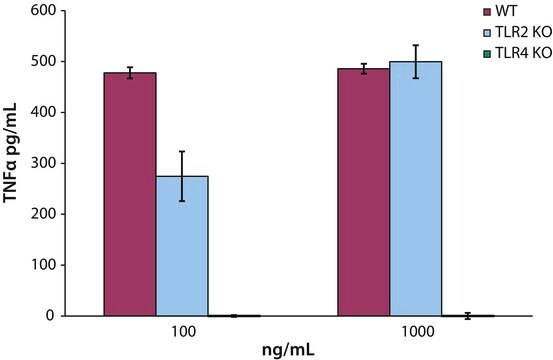L6893
Lipopolysaccharides (rough strains) from Escherichia coli F583 (Rd mutant)
Synonym(e):
LPS
Anmeldenzur Ansicht organisationsspezifischer und vertraglich vereinbarter Preise
Alle Fotos(2)
About This Item
Empfohlene Produkte
Biologische Quelle
Escherichia coli (F583 Rd mutant)
Qualitätsniveau
Form
lyophilized powder
Verunreinigungen
<3% Protein (Lowry)
Farbe
white to yellow cast
Löslichkeit
water: 4.90-5.10 mg/mL, cloudy to turbid, colorless to faintly yellow
Versandbedingung
ambient
Lagertemp.
2-8°C
Allgemeine Beschreibung
This product is phenol:chloroform:petroleum ether extracted from E. coli F 583 (Rd mutant). The source strain is from a private collection.
Anwendung
Lipopolysaccharides (LPSs) are characteristic components of the cell wall of Gram-negative bacteria. LPS and its lipid A moiety stimulate cells of the innate immune system by the Toll-like receptor 4 (TLR4), a member of the Toll-like receptor protein family, which recognizes common pathogen-associated molecular-patterns (PAMPs).
Biochem./physiol. Wirkung
Lipopolysaccharides (LPS) are localized in the outer layer of the membrane and are, in noncapsulated strains, exposed on the cell surface. They contribute to the integrity of the outer membrane, and protect the cell against the action of bile salts and lipophilic antibiotics.
Angaben zur Herstellung
Prepared by phenol-chloroform-petroleum ether extraction.
The product is soluble in water (5 mg/ml) or cell culture medium (1 mg/ml) yielding a hazy, faint yellow solution. A more concentrated, though still hazy, solution (20 mg/ml) has been achieved in aqueous saline after vortexing and warming to 70-80 oC. Lipopolysaccharides are molecules that form micelles in every solvent. Hazy solutions are observed in water and phosphate buffered saline. Organic solvents do not give clearer solutions. Methanol yields a turbid suspension with floaters, while water yields a homogeneously hazy solution.
The product is soluble in water (5 mg/ml) or cell culture medium (1 mg/ml) yielding a hazy, faint yellow solution. A more concentrated, though still hazy, solution (20 mg/ml) has been achieved in aqueous saline after vortexing and warming to 70-80 oC. Lipopolysaccharides are molecules that form micelles in every solvent. Hazy solutions are observed in water and phosphate buffered saline. Organic solvents do not give clearer solutions. Methanol yields a turbid suspension with floaters, while water yields a homogeneously hazy solution.
Sonstige Hinweise
To gain a comprehensive understanding of our extensive range of Lipopolysaccharides for your research, we encourage you to visit our Carbohydrates Category page.
Signalwort
Danger
H-Sätze
Gefahreneinstufungen
Acute Tox. 2 Oral
Lagerklassenschlüssel
6.1A - Combustible acute toxic Cat. 1 and 2 / very toxic hazardous materials
WGK
WGK 3
Flammpunkt (°F)
Not applicable
Flammpunkt (°C)
Not applicable
Persönliche Schutzausrüstung
Eyeshields, Gloves, type N95 (US)
Hier finden Sie alle aktuellen Versionen:
Besitzen Sie dieses Produkt bereits?
In der Dokumentenbibliothek finden Sie die Dokumentation zu den Produkten, die Sie kürzlich erworben haben.
Kunden haben sich ebenfalls angesehen
M Worku et al.
Journal of dairy science, 92(7), 3185-3193 (2009-06-17)
The objective of this study was to evaluate the effect of smooth (S) and rough (R) forms of lipopolysaccharide (LPS) on gene expression in bovine blood neutrophils. Isolated neutrophils (10(7) cells/mL) were treated with Escherichia coli LPS serotype O111:B4 (S+R)
Yawen Ni et al.
PloS one, 12(2), e0170346-e0170346 (2017-02-09)
Occludin is a key tight junction (TJ) protein in cerebral endothelial cells (CECs) playing an important role in modulating blood-brain barrier (BBB) functions. This protein (65kDa) has been shown to engage in many signaling pathways and phosphorylation by both tyrosine
Iga Kucharska et al.
Biochemistry, 55(36), 5061-5072 (2016-08-18)
Pseudomonas aeruginosa is an opportunistic human pathogen causing pneumonias that are particularly severe in cystic fibrosis and immunocompromised patients. The outer membrane (OM) of P. aeruginosa is much less permeable to nutrients and other chemical compounds than that of Escherichia
G Werner-Felmayer et al.
Clinical and diagnostic laboratory immunology, 2(3), 307-313 (1995-05-01)
In a number of mammalian cell types, pteridine biosynthesis from guanosine 5'-triphosphate and formation of nitric oxide from L-arginine are induced by gamma interferon (IFN-gamma) and bacterial lipopolysaccharide (LPS). We assessed the possibility of using such metabolic alterations for the
Unser Team von Wissenschaftlern verfügt über Erfahrung in allen Forschungsbereichen einschließlich Life Science, Materialwissenschaften, chemischer Synthese, Chromatographie, Analytik und vielen mehr..
Setzen Sie sich mit dem technischen Dienst in Verbindung.



